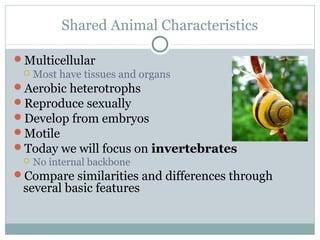
Intro to invertebrates tz sp15
- 1. Shared Animal Characteristics Multicellular Most have tissues and organs Aerobic heterotrophs Reproduce sexually Develop from embryos Motile Today we will focus on invertebrates No internal backbone Compare similarities and differences through several basic features
- 2. Symmetry Radial symmetry: body parts arranged around a central axis Bilateral symmetry: have a front and back end and right and left side
- 3. Embryo Tissue Layers Zygote develops into a mass of cells Primary tissue layers form Simple radial animals have two layers Outer ectoderm Inner endoderm Bilateral animals have a third layer, mesoderm in the middle
- 4. Pattern of Development Protostome: first embryo opening becomes the mouth Examples: flatworms, molluscs, roundworms, arthropods Deuterostome: second embryo opening becomes the mouth Example: Echinoderms, chordates
- 5. Body cavity: Coelom Cavity between the gut and the wall that is lined with tissue Cushions organs Helps organs grow and move independently 3 types of body cavities
- 6. Acoelomate: no body cavity Flatworms Pseudocoelmate: false cavity Partially lined Roundworms Coelomate: true cavity Higher animals
- 8. Sponges: Phylum Porifera No true tissues No germ layers Acoelomates No symmetry Sessile adult Asexual and sexual reproduction Spicules: made of different substances; for protection Collar cells (choanocytes)-flagellated, create water currents Amoebocytes-digestion, secretion Epidermal cells-cover surface Osculum: largest opening for water
- 10. Jellyfish Phylum Cnidaria Radial Symmetry Two germ layers Simple tissues Acoelomates Polyp and/or medusa stage Stinging cells—Cnidocytes with nematocysts Fluid filled capsule with thread Nerve net
- 11. Hydra-cnidarian example Look at slides and live specimens
- 12. Roundworms: Phylum Nematoda Bilateral symmetry Three germ layers Molt their cuticle Pseudocoelomates Cephalization with brain Complete digestive system (2 openings) Many parasites
- 13. Roundworm examples Ascaris: intestinal parasite, infects humans Trichinella: encysts in human muscles causing trichinosis Vinegar eels: live specimen
- 14. Three germ layers Coelomates Bilaterally symmetrical Jointed appendages Exoskeleton with chitin Specialized segments Cephalization Phylum Arthropoda
- 15. Arthropod Lineages Trilobites (all extinct) Crustaceans (crabs, shrimps, barnacles) Chelicerates (spiders, mites, scorpions) Uniramians (insects, centipedes, millipedes) Today: dissect a crayfish
- 17. Wear goggles, gloves, and lab coats Carosafe safety procedures Put specimens in correct containers No gloves or paper towels with tissue waste No unauthorized dissections-please treat specimens with respect Clean all dissection equipment at conclusion Important Dissection Notes
Hinweis der Redaktion
- White-lipped snail.Authored by: Mad Max.Located at: https://en.wikipedia.org/wiki/File:Snail-WA_edit02.jpg.License: CC BY-SA: Attribution-ShareAlike
- Pacific Sea Nettle. Authored by: cotinis. Located at: https://www.flickr.com/photos/pcoin/2999690280. License: CC BY-NC-SA: Attribution-NonCommercial-ShareAlike Bilateral symmetry. Authored by: Matt Reinbold. Located at: https://www.flickr.com/photos/furryscalyman/603093359. License: CC BY-SA: Attribution-ShareAlike
- Embryo Tissue Layers. Authored by: OpenStax College. Provided by: Rice University. Located at: http://cnx.org/contents/185cbf87-c72e-48f5-b51e-f14f21b5eabd@9.85:139/Biology. License: CC BY: Attribution
- Protostomes and Deutorostomes. Authored by: YassineMrabet. Located at: https://commons.wikimedia.org/wiki/File:Protovsdeuterostomes.svg. License: CC BY-SA: Attribution-ShareAlike
- Features used to classify animals. Authored by: OpenStax College. Provided by: Rice University. Located at: http://cnx.org/contents/7289a2d7-803c-49ef-905a-01324d155936@5/Features-Used-to-Classify-Anim. License: CC BY: Attribution
- Metazoan Phylogenetic Tree. Authored by: Schierwater B, Eitel M, Jakob W, Osigus H-J, Hadrys H. Located at: https://commons.wikimedia.org/wiki/File:Metazoan_Phylogenetic_Tree.png. License: CC BY: Attribution
- Phylum Porifera. Authored by: OpenStax College. Provided by: Rice University. Located at: http://cnx.org/contents/185cbf87-c72e-48f5-b51e-f14f21b5eabd@9.85:143/Biology. License: CC BY: Attribution Barrel sponge. Authored by: Twilight Zone Expedition Team 2007, NOAA-OE. Provided by: NOAA Photo Library. Located at: https://commons.wikimedia.org/wiki/File:Reef3860_-_Flickr_-_NOAA_Photo_Library.jpg. License: CC BY: Attribution
- Grantia slide. Provided by: The Biology Web. Located at: https://b51ab7d9e5e1e7063dcb70cee5c33cf7f4b7bad8.googledrive.com/host/0Bx6hk6AUBHxDc2d4TDJZTFIyMGs/files/Bio%20102/Bio%20102%20Laboratory/Animal%20Diversity/Porifera,%20Radiata/Sponges.html. License: CC BY-NC-SA: Attribution-Noncommercial-ShareAlike
- Jellyfish Phylum Cnidaria. Authored by: Ulybug. Located at: https://commons.wikimedia.org/wiki/File:Jellyfish_--_by_Ulybug.jpg. License: CC BY: Attribution Nematocyst Discharge. Authored by: Spaully. Located at: https://commons.wikimedia.org/wiki/File:Nematocyst_discharge.png. License: CC SA: ShareAlike
- Hydra vulgaris, a hydrozoan cnidarian. Authored by: Corvana. Located at: https://en.wikipedia.org/wiki/Hydra_vulgaris#/media/File:Hydravulgaris.jpg. License: CC BY-SA: Attribution-Share-Alike
- Filariform hookworm. Provided by: Centers for Disease Control. Located at: http://www.cdc.gov/dpdx/hookworm/gallery.html#filariform. License: Public Domain: No Known Copyright
- Trichinella spiralis larvae. Authored by: Froggerlaura. Located at: https://commons.wikimedia.org/wiki/File:Trichinella_spiralis_larvae_within_muscle.jpg. License: CC BY-SA: Attribution-ShareAlike
- Abludomelita obtusata. Authored by: Hans Hillewaert. Located at: https://commons.wikimedia.org/wiki/File:Abludomelita_obtusata.jpg. License: CC BY-SA: Attribution-ShareAlike Mexican red-kneed tarantula. Authored by: George Chernilevsky. Located at: https://commons.wikimedia.org/wiki/File:Brachypelma_smithi_2009_G07.jpg. License: Public domain: No Known Copyright Blue morpho butterfly. Authored by: Alias 0591. Located at: https://www.flickr.com/photos/renemensen/5312691985/. License: CC BY: Attribution
- Crayfish Astacus astacus. Authored by: Anonymous. Provided by: National Park. Located at: https://commons.wikimedia.org/wiki/File:Ecrevisse_pattes_rouges.jpg. License: CC BY-SA: Attribution-Share-Alike Colorado potato beetle. Authored by: Scott Bauer, U.S. Department of Agriculture. Located at: https://commons.wikimedia.org/wiki/File:Colorado_potato_beetle_leptinotarsa_decemlineata_insect.jpg. License: Public Domain: No Known Copyright
- Crayfish dissection. Provided by: The Biology Web. Located at: https://b51ab7d9e5e1e7063dcb70cee5c33cf7f4b7bad8.googledrive.com/host/0Bx6hk6AUBHxDc2d4TDJZTFIyMGs/files/Bio%20102/Bio%20102%20Laboratory/Animal%20Diversity/Ecdysozoans/Arthropods.html. License: CC BY-NC-SA: Attribution-Noncommercial-ShareAlike
